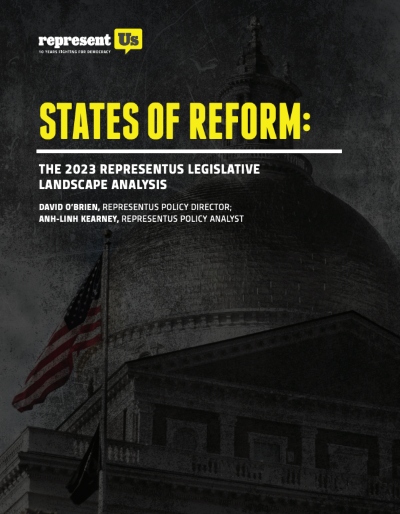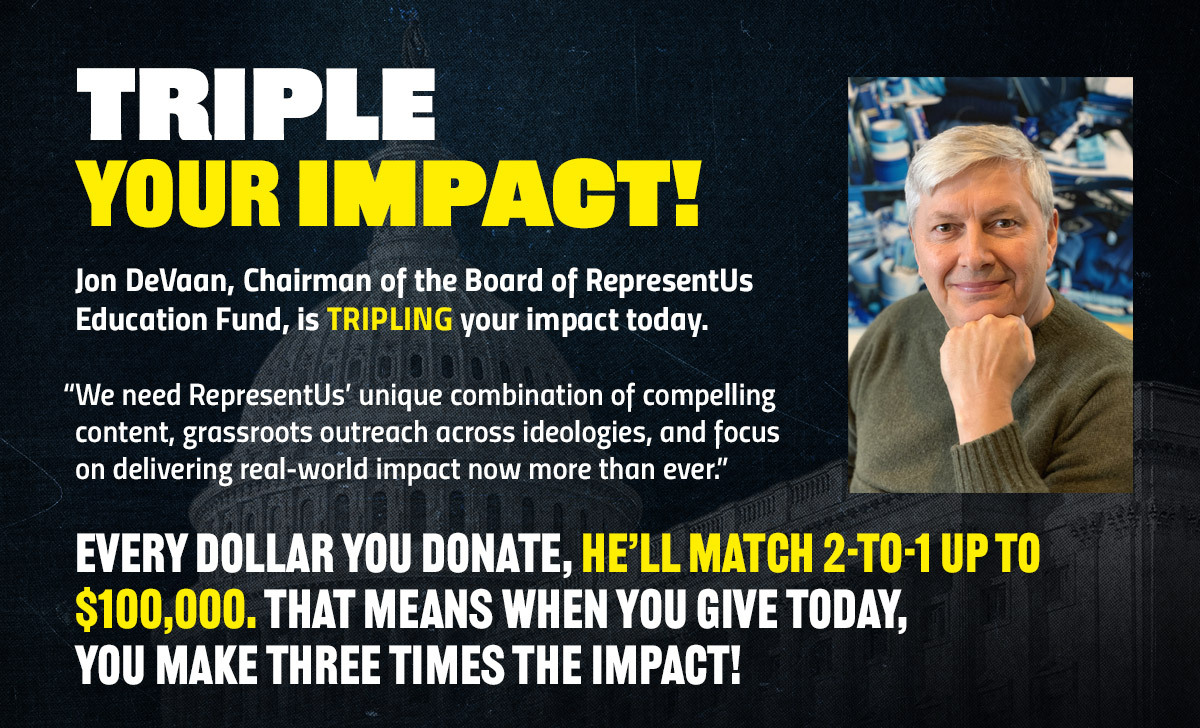States of Reform
The 2023 RepresentUs Legislative Landscape Analysis
🎉States of Reform is a first-of-its-kind report to show both the progress and obstacles the pro-democracy movement encountered over the past year. Read on to discover how lawmakers tried to strengthen or undermine democracy across the country in 2023.
Introduction
 |
Report by Dave O’Brien, Policy Director |
 |
and Anh-Linh Kearney, Policy Analyst |
One of the first things you notice when you start researching proposed election laws is that there are a lot of them. Hundreds. Thousands even. And more are introduced every year. This can make it hard to keep track of what’s going on in the world of democracy reform. Who’s considering proposals you like? Who’s trying to do things you hate? Who’s working on things you’ve never even heard of?
Another thing you’ll notice is that it can be hard to categorize proposed election laws. Is it a minor, technical adjustment or a significant change to the election process? Does it cover a single, discrete subject or several?
As an organization that works to pass pro-democracy laws (and defeat anti-democracy ones) across the country, we try to keep track of the various proposals that get introduced every legislative session. There are some excellent tools to track proposed election laws already—many of which we used to create this report—but most of them are either narrowly focused on a specific topic or broadly focused on all election legislation. After years of waiting for a single resource that covers all state legislation over our areas of interest, we decided to make it ourselves.
It’s our hope that, in a time of pessimism about the future of democracy, this report conveys how active and vibrant the democracy movement is.
Many of the subjects in this report cover our main areas of advocacy. Others are policies with exciting potential that we’re keeping an eye on. This list of proposals includes pieces of legislation that we supported and promoted as well as others that we opposed. A proposal’s inclusion in this report doesn’t necessarily mean that we support or endorse it.
We have tried to make this report as comprehensive as possible without being overwhelming. In that spirit, this report focuses on:
- Legislatures – This report only tracks proposals that were introduced in legislatures. It doesn’t include attempts by members of the public to place questions on the ballot through an initiative process. Referrals by legislatures to place ballot measures on the ballot for public approval are included in this report, but initiatives that qualify for the ballot through a signature drive, without first going through a legislature, are not. It also doesn’t include changes in rules and regulations by state agencies.
- Legislation – This report only tracks proposals that, if passed, would change the law. Bills and resolutions that would either change laws directly or refer questions to the ballot are included, while other legislative actions that wouldn’t change the law or otherwise affect how elections are conducted (such as committee hearings or symbolic resolutions declaring support or opposition to the subjects of this report) are not.
- States – This report only tracks proposals introduced in state legislatures. It doesn’t track proposals in Congress or local legislatures, like city councils. Many of these proposals would affect federal and local elections, but they are all introduced at the state level.
Even with these restrictions we had to make some difficult calls. “Campaign finance,” for example, is such a big topic that it could be its own report. We decided to focus on a few subcategories of that topic with the most exciting potential for growth. Every section provides a brief description of the subject area and an explanation why we think it’s worth monitoring.
It’s our hope that, in a time of pessimism about the future of democracy, this report conveys how active and vibrant the democracy movement is. We also hope that democracy advocates will use the information in this report to inform their efforts, helping them to decide what and where the greatest opportunities and threats are.
Toplines
Through our research we observed widespread national interest in ranked choice voting, it was a banner year for introducing it and banning it. We also saw attacks on direct democracy, like the supermajority requirement in Ohio that lawmakers referred to the August 2023 ballot (and defeated by voters). We saw new and emerging campaign finance reforms, from expanding public campaign financing to banning foreign-influenced corporations from spending in our elections. There was a wide variety of approaches introduced to change primary elections, growing interest in state-level voting rights acts, and progress made on mail voting since the COVID-19 pandemic.
- Widespread national interest in ranked choice voting (RCV), both positive and negative – Legislators introduced bills and resolutions about RCV in thirty-seven states and the Commonwealth of Puerto Rico. The vast majority of this legislation was favorable to RCV, but there are signs of opposition. Legislators in five states passed laws to ban RCV, two of which were vetoed, leaving three states with new RCV bans on the books.
- Attacks on direct democracy through proposals to undermine the ballot initiative process – The Ohio legislature’s attempt to raise the number of votes a constitutional amendment needs to pass to a 60% supermajority was probably the most high-profile example, but legislators across the country introduced bills designed to make it harder to pass laws by a citizens’ initiative. The news isn’t all bad for direct democracy supporters. Legislators in nine states introduced legislation to create or resurrect an initiative process, although none of them passed.
- Other emerging structural reforms – the variety of approaches to changing primary elections, burgeoning campaign finance reforms, the growing interest in state-level voting rights acts, the progress of mail voting since the beginning of the COVID-19 pandemic—are discussed in more detail in this report.
Totals at-a-glance:
| Category | Total bills | Total passed by state legislatures (incl. vetoes) |
| Overall | 350 | 37 (5 vetoes) |
| Ranked-Choice Voting | 108 | 11 (2 vetoes) |
| Direct Democracy | 58 | 8 |
| Vote-by-Mail | 53 | 6 (2 vetoes) |
| Primary Reform | 52 | 6 |
| Campaign Finance Reform | 41 | 5 (1 veto) |
| Redistricting | 26 | 1 |
| State Voting Rights Act | 10 | 2 |
| Proportional Representation | 19 | 1 |
Background and Methodology
The data in this report comes from a wide network of resources provided by the leading organizations in each of these respective policy areas. We owe an enormous debt to organizations like FairVote, the National Conference of State Legislatures, Voting Rights Lab, National Vote at Home Institute, the Ballot Initiative Strategy Center, the Initiative and Referendum Institute, and the Brennan Center for their extremely helpful tools and resources. Our research team identified resources where these policies are tracked, and filled in any missing gaps with our own searches using Legiscan. Keep in mind that it’s nearly impossible for this search to be conclusive. Bills can change in a myriad of ways throughout the legislative process, specific terms are not always consistent from state-to-state, and some pieces of legislation will inevitably be left out. We have tried our best to be comprehensive, but achieving total coverage is often more of an aspirational process than a realizable endpoint.
Since legislative proposals can include multiple subjects (and even the lines between subject areas themselves can be blurry), many proposals appear in more than one section. A bill to adopt Alaska-style Top Four elections, for example, will appear in both the ranked choice voting and primary reform sections.
While numbers can be useful, numbers alone don’t reveal the effort that goes into passing a law or provide much insight into a legislative reform effort. Put simply, it’s very hard to pass a law. The vast majority of bills that get introduced in a year won’t be passed. Successful proposals are often unsuccessfully introduced for years before they finally get traction. Experienced advocates understand that sometimes even a small fraction of their proposals becoming law in a legislative session can be an extraordinary success. The best way to understand a movement’s overall legislative success is not to look at a single session in isolation but to look at trends over time, which we hope this report can provide in years to come.
Terminology
Each section contains definitions relevant to its subject matter, but there are a few terms that recur throughout the report.
- A bipartisan bill is a bill that is sponsored by a group of legislators who are members two different parties or members of one party and independent legislators.
- A committee bill is a bill produced by a legislative committee instead of an individual legislator. The rules for introducing committee bills vary by state, and committee bills often don’t include the names of individual legislators, which can make it difficult to determine the partisanship of their supporters.
- A state with a divided government is one where the governorship and the legislature, or the two chambers of the legislature, aren’t controlled by the same political party.
- A multipartisan bill is a bill sponsored by a group of legislators who are members of more than two parties, including independent legislators.
- A bill’s sponsor is a legislator who proposes or introduces it to the legislature for consideration.
- A study bill is a bill that creates a body or directs an existing body to research a particular issue and produce recommendations on what the state should do about it.
- A state with a governing trifecta is one where the governorship and both chambers of the legislature are controlled by the same party.1
A note on the categories used for our Toplines and Fast Stats analysis. “Total passed” or “Total passed by state legislatures” refers to the number of proposals that have successfully made it through a state legislature. This includes proposals that were vetoed by governors. “Vetoes” refers to proposals that have made it through a state legislature but were vetoed by the governor and therefore did not become law. “Total passing only one chamber” refers to proposals that were passed by one half of a state legislature (e.g., just a state senate or just a state house or representatives) but failed to make it through the other half. While these proposals didn’t make it far enough to become law (or even be vetoed), passing one chamber is an indication that a proposal has some significant momentum and political support. Finally, “proposals” and “pieces of legislation” are used throughout the report to reflect that fact that the things we track include both bills and resolutions.
Acknowledgments
This report would not have been possible without the support and work of many individuals and organizations whom we wish to thank here. First, thanks to Alexi Santiago and Saayom Ghosh for their research support, this report would not exist without them. This product was informed by excellent research by organizations like FairVote, National Vote at Home Institute, the Ballot Initiative Strategy Center, the Initiative and Referendum Institute, Unite America, Voting Rights Lab, the Brennan Center, the Campaign Legal Center, the Bipartisan Policy Center, the National Conference of State Legislatures, and Ballotpedia. We thank them for the resources and research they continue to provide to propel the movement forward. We’d also like to thank the numerous staffers, at our organization and at our partner organizations, for their thoughtful review and feedback on this report.
Links and Resources
The following reports and resources played a vital role in the creation of this report.
Footnotes
1 Nebraska, whose unicameral legislature has a single chamber, would be considered a trifecta state for the purposes of this report. We relied on Ballotpedia’s State government trifectas page to identify states with trifectas and divided governments.



